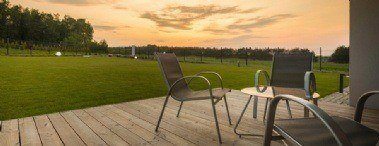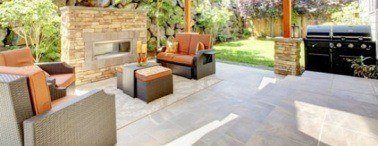
It used to be that decks were built out of raw wood and then painted or stained to maintain their appearance and integrity. This usually worked well for years, that is, until the water finally did its work in the crevices and the non-painted supports began to rot. This caused the deck to slouch and then the decking to rot from the bottom-side up.
The truth is that raw wood can take water in short bursts. You often see fences and barns over a hundred years old still standing. The reason they collapse is that water on the foundation and was constantly soaked up into the wood. Otherwise, if you cut the grey, weathered boards in half you'd still see a glimmer of raw wood.
Decking and deck supports have come a long way in the past few decades. Pressure-treating has made a big difference allowing the wood to be awash in water and still not rot. This shows with the changes in the materials used to build a deck, especially the decking itself. Now a deck is not a high-maintenance appendage to the home but a valued investment that will bring returns when the home is sold.
Types of Decking Materials
1. Pressure-Treated Wood
The big problem with natural wood is that when it gets wet bacteria, mildews and many varieties of insects feed on it. This is especially true when wood touches the ground or is immersed in a moist condition for a period of time. Depending on the area most untreated, softwood varieties will last only 2-3 years in moist conditions. This is where the magic of pressure treating comes in.
Thanks to the invention of pressure-treating even soft varieties like spruce can withstand the weather and moisture as well as, or better than, cedar and redwood. Pressure-treated wood is softwood that has been immersed in a bath of preservative and then put in a pressurized tank. The pressure drives the preservative into the wood cells right to the heart of piece.
Until the Environmental Protection Agency banned the substance in 2003, chromated copper arsenate (the bright green stuff) was the common chemical preservative. This is because copper is deadly to a wide spectrum of insects and fungi. In the new preservative, alkaline copper quat, or ACQ, copper is still used, but the compound is not as harmful to the environment.
Most decks built today use pressure-treated wood, if not for the decking then for the support system. Dollar for dollar, it is still the best material to use and you see it in commercial boardwalks and large decking projects.
2. Cedar and Redwood
Because of its natural oils, cedar is resistant to rot and insects. It is light, easy to work with, and rated to have half the shrinking and swelling tendencies of other softwoods. Both cedar and redwood age to a beautiful, natural silver color so that yearly maintenance is not required.
These woods are more expensive but increase the value of the home without having to replace the deck in 10-15 years. Many people choose to use pressure treated lumber for the structure and cedar and redwood for the decking. However, cedar also comes in joists, rails and 4' x 4' posts.
3. Composite Decking
For the past decade composite products have been moving in to the decking market. Composite decking is a mixture of wood fiber and ground-up, recycled plastic that is pressed into planks with a realistic wood grain. Composite decking will not shrink, warp, or split the way pressure-treated wood tends to do.
Composite material is more expensive than traditional lumber but will outlast wood and is virtually maintenance-free. However, although the planks are colored right through, the surface may fade in direct sunlight and tend to get hot underfoot during long exposure times to the sun.
Many types of composite planks are complete imitations of their wooden counterparts. They have the woodgrain look and can be cut, drilled and theirs ends sanded just like wood (sanding the surface would not be advised). Other makers of composite planks make a product with hollow rectangles or channels to make the product lighter.
4. Hollow Vinyl Decking
The base thickness of hollow polyvinylchloride (PVC) decking is barely a fraction of an inch thick. The companies use honeycombing to make it strong while keeping it light. Whereas composite decking contains from 10% to more than 60% wood filler to plastic or vinyl material, vinyl decking is pure vinyl with maybe carbon or fiberglass fibers added for strength.
Most PVC products, including decking and siding, are now made of two layers of PVC layers of differing qualities. The capstock, or coating layer, contains a UV inhibitor, usually titanium dioxide, as well as other additives which give it its appearance and resistance to denting. The core gives it the structural quality and is typically thicker. But this stratification is very thin in hollow PVC.
5. Solid Core Vinyl
Most solid vinyl decking materials are made with a cellular PVC process. Cellular polyvinylchloride is an extruded material, meaning that it is forced through a die rather than molded. This is achieved created by foaming the PVC, creating tiny air bubbles, which means that the product has a density less than half that of regular vinyl. Being that it acts like real wood it is used for interior and exterior trim work and, and is prevalent in windows and doors.
6. Aluminum Decking
Like aluminum soffit and railing systems, this decking material is lightweight and easy to install. Being a relatively new product only time will tell if this product will stand up to the punishment of thousands of footfalls. It will never warp, crack, split, or twist and mold or mildew are non-existent because there is nothing to feed on. However at $7+ a square foot it is the most expensive of the non-woods.
So, which material attracts you a bit more than the others? It will mostly depend upon your budget, but sometimes you can modify the design to go for a smaller, but more upscale decking. Don't forget to look at our large collection of deck photos, from projects completed to perfection by trusted deck contractors listed with us.
Posted by: TrustedPros





